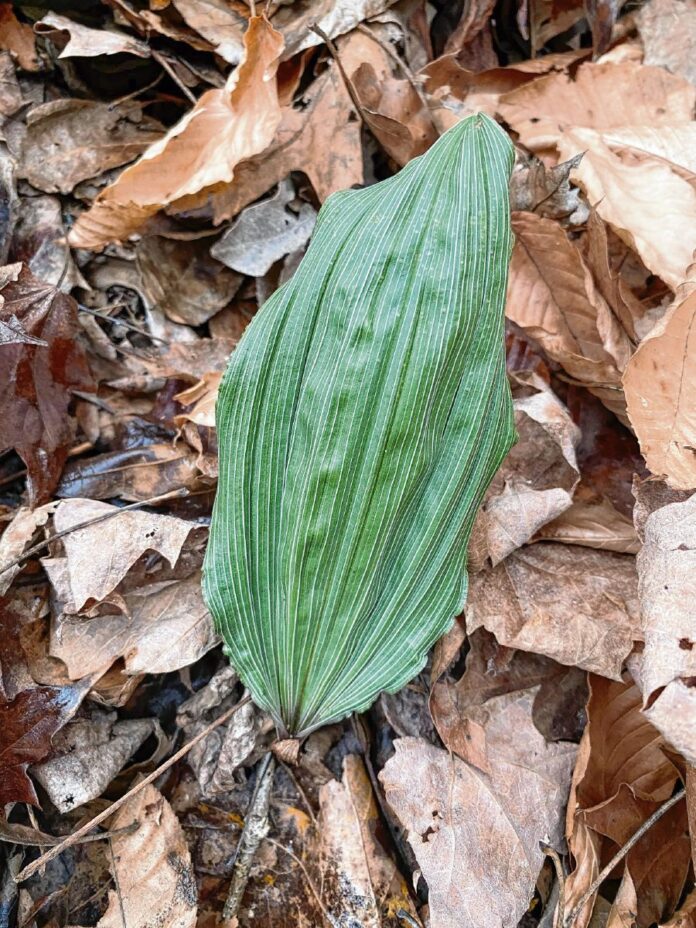By LESLIE BISHOP, guest columnist
Shades of brown litter the forest floor. Dried leaves crunch and crinkle under foot. The December landscape reveals subtle beauty: the long shadows from tall bare trees on slopes, the stark white branches of sycamore reaching upward, and the accentuated textures of different trees’ bark.
On this cold winter day, I was searching for something more specific. I was searching for orchids.
Orchids in winter? My quest was puttyroot orchid, whose scientific name is Aplectrum hyemale. The term “hyemale” is derived from the Latin “hiemalis,” meaning of or about winter.
This species has the unusual life history of producing a single oval leaf with parallel veins lined in white in late November through December. This distinctive dark-green leaf with a purplish stem stands out against the browns of the forest floor. The orchid’s single leaf persists until spring, when it shrivels up and disappears.
[sc:text-divider text-divider-title=”Story continues below gallery” ]This single leaf has an important job. It must capture energy from the sun for photosynthesis. The puttyroot orchid’s strategy for this job is to take advantage of a time when the most light reaches the forest floor: during the winter when the leaves are off the trees. The leaf can continue photosynthesis even under a light layer of snow with temperatures in the 30s F.
The carbohydrate products of photosynthesis are stored in underground corms, bulb-like swollen stems, which allow the plant to survive through the seasons. The substance within the corm is sticky like putty, hence the common name. A study from the 1940s showed that this sticky, or mucilaginous, substance in the corm allows the plant to absorb water during periods of water stress, like in winter or during droughts.
In the spring, when the forest floor explodes in a frenzy of spring wildflowers and ferns, the puttyroot orchid corm sends up a single flower stalk. The orchid blooms in May-June but chances are, you have never noticed. Even though the impressive winter leaf was showy, the diminutive flowers are hard to see amid the chaos of spring green. And yet, if you took the initiative to mark where you saw the winter leaf, you might be rewarded with seeing a flowering stalk.
We often think of orchids as the big, showy queens of corsages for special occasions. But these native orchids are small and discreet. Typically, there are eight to 15 small, yellowish-greenish flowers on the stalk. If you zoom in on a single flower with a magnifying glass or hand lens, you would see a perfectly beautiful “typical” orchid flower, with asymmetrical petals in cream with purple tips.
Solitary bees are the likely pollinators, yet definitive studies have not been done on the pollination of puttyroot. It has been observed that the puttyroot flowers can self-pollinate in the absence of insects. However pollination is achieved, the plant produces seed capsules loaded with tiny powdery seeds.
Some years, the orchid doesn’t bloom, even though the leaf appears in winter. And in other years, the entire plant is dormant without even the appearance of the leaf. Thus, finding any stage of this plant is lucky.
On our walk, my dog was distracted by the smell of an animal and, nose to ground, veered off the trail. As I chased after my dog to hook her up to her leash, our off-trail adventure led us to a deeply cut drainage ditch on the forest slope. There, I spotted the winter leaves of puttyroot. My excitement even lured my dog back to see what I was seeing. Not only did we see the winter leaves of the orchid, but also the brown dried stalk with seed capsules.
We were lucky. My search was complete. My dog’s search was derailed.
Now is the time to locate these secretive orchids. I will take note of where I found the leaves, and I will return in the spring to watch for the flowers.
This is how I find joy, and this year more than most, I must look for joy. The winter can be gray and dreary, but the small, intricate miracles of the forest can be constant reminders.
As the poet Holly Hughes says, “— as if this quiet day / with its tentative light weren’t enough, / as if joy weren’t strewn all around.”

Leslie Bishop is a Brown County resident and retired biology professor from Earlham College. She can be reached through the newspaper at [email protected].





